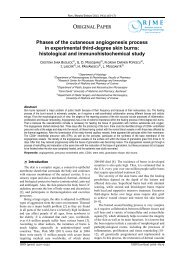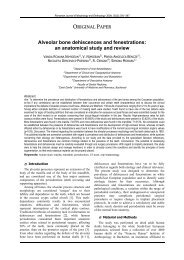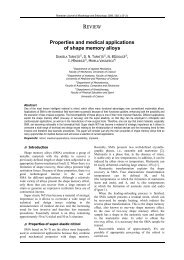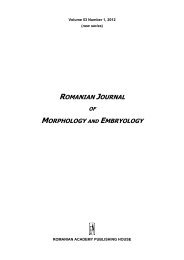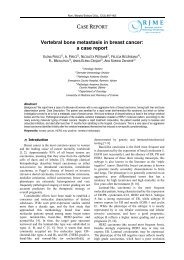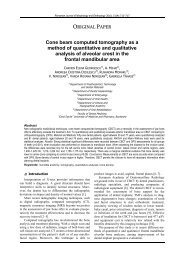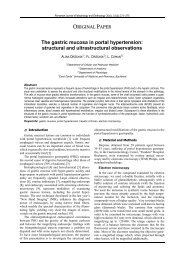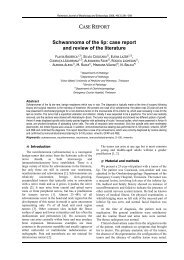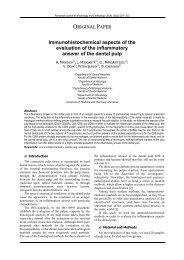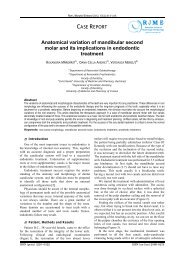Dowling–Degos disease - Rjme.ro
Dowling–Degos disease - Rjme.ro
Dowling–Degos disease - Rjme.ro
You also want an ePaper? Increase the reach of your titles
YUMPU automatically turns print PDFs into web optimized ePapers that Google loves.
184it is thought that they could be due to clinical manifestationof a single underlying defect in follicularkeratinization. Identically, for the same of the otherconditions, their coexistence in the same patient is likelyto reflect the same follicular anomaly. It is possibly thata single underlying defect of follicular p<strong>ro</strong>liferation mayaccount for the coexistence of these conditions.Histological, the affected skin shows elongatedepidermal rete ridges with thinning of the suprapapillaryepithelium and basilar hyperpigmentation in afiliform pattern. Perivascular lympho-histiocytic dermalinfiltration and dermal fib<strong>ro</strong>sis along elongated reteridges are observed [8]. Also, intra-epidermalkeratincysts may be remarked [16]. Occasionally, hamartomatousepidermal changes have been identified [16, 22].The downward elongation is composed of regularpigmented basaloid cells. An increased number ofmelanophages has been observed in, with no quantitativeincrease in the number of melanocytes [5].In a latest study, all pigmented cells in the basallayer were recognized by anti-PEP-1, anti-PEP-2,HMB-45 and NK1/beteb antibodies. The melanocyteswere localized in the basal layer and accounted for 10%of the total keratinocytes. Supranuclear “caps” of b<strong>ro</strong>wngranules were observed within most basal keratinocytesin the hyperpigmentation area. The melanocytes containedmany mitochondria, Golgi apparatus, and regularmelanosomes in all stages of maturation in theircytoplasm; melanosome-laden dendrites were readilydetected by transmission elect<strong>ro</strong>n mic<strong>ro</strong>scope. Melanosomesmainly of stages III and IV were evident withinkeratinocytes either distributed as scattered patterns orforming “caps” over the nucleus [23].Differential diagnoses include acanthosis nigricansand other human genetic pigmental <st<strong>ro</strong>ng>disease</st<strong>ro</strong>ng>, such asreticulate ac<strong>ro</strong>pigmentation of Kitamura (RAPK), dysch<strong>ro</strong>matosissymmetrica hereditaria (DSH), dysch<strong>ro</strong>matosisuniversalis hereditaria (DUH).In acanthosis nigricans, the plaques are velvety andthere may be skin tags but no dark comedone-likelesions. Histologically, there is papillomatosis in acanthosisnigricans and no follicular anomalies.The onset of RAPK is in the first two decades oflife. The location of macules is acral rather thanflexural. There are palmar and plantar pits and breaks inthe epidermal ridge pattern, which were not found inthis patient. The histological features of DDD andRAPK are however, very similar; RAPK lacking onlythe antler-like pattern of the epithelial p<strong>ro</strong>liferation.Several authors reported that <st<strong>ro</strong>ng>Dowling–Degos</st<strong>ro</strong>ng> <st<strong>ro</strong>ng>disease</st<strong>ro</strong>ng>and RAPK might be different clinical expressions of thesame <st<strong>ro</strong>ng>disease</st<strong>ro</strong>ng> [10].DSH is an autosomal dominant inheritancecharacterized by pinpoint, pea-sized, hyperpigmented,and hypopigmented macules limited largely to thedorsal aspects of the hand and feet [24].DDD are dominated by spotted and reticulatepigmentation of the flexures. In addition, the gene forDSH has previously been mapped to ch<strong>ro</strong>mosome1q11–1q21 [25], in which the RNA-specific adenosinedeaminase gene was identified as the <st<strong>ro</strong>ng>disease</st<strong>ro</strong>ng> gene forDSH [10, 24, 26].E. F. Georgescu et al.Dysch<strong>ro</strong>matosis universalis hereditaria is characterizedby pigmented flecks and spots over much of thebody other than that limited to the flexures of body [26].In addition, the gene for dysch<strong>ro</strong>matosis universalishereditaria has previously been mapped to ch<strong>ro</strong>mosome6q24.2–q25.2 [26].DDD exhibits a slow p<strong>ro</strong>gressive course. Treatmentof DDD is complicated, usually with poor results.Transient good results have been reported with the useof topical corticoste<strong>ro</strong>ids, depigmentating agents,topical adapalene and Er: YAG laser pulse energybetween 1000 and 1200 mJ, three consecutive passes[27, 28]. These treatments led to a good clinical resultand might be a successful strategy in DDD. ConclusionsThe clinical aspects and the histopathological examinationdiscovered in our patient are correlated with thediagnosis of DDD, with possible familial history in herson. Treatment of DDD is complicated and usually whichpoor results. It necessary ample studies on a nume<strong>ro</strong>uspatients with this rare <st<strong>ro</strong>ng>disease</st<strong>ro</strong>ng> for evaluation the efficacyand safety of the different therapeutically variants.References[1] SANDHU K, SARASWAT A, KANWAR AJ, <st<strong>ro</strong>ng>Dowling–Degos</st<strong>ro</strong>ng><st<strong>ro</strong>ng>disease</st<strong>ro</strong>ng> with dysch<strong>ro</strong>matosis universalis hereditaria-likepigmentation in a family, J Eur Acad Dermatol Venereol,2004, 18(6):702–704.[2] OISO N, TSURUTA D, OTA T, KOBAYASHI H, KAWADA A,Spotted and rippled reticulate hypermelanosis: a possiblevariant of <st<strong>ro</strong>ng>Dowling–Degos</st<strong>ro</strong>ng> <st<strong>ro</strong>ng>disease</st<strong>ro</strong>ng>, Br J Dermatol, 2007,156(1):196–198.[3] DOWLING GB, FREUDENTHAL W, Acanthosis nigricans, Br JDermatol, 1938, 50:467–471.[4] DEGOS R, OSSIPOWSKI B, Dermatose pigmentaire réticuléedes plis, Ann Dermatol Syphiligr, 1954, 81:147–151.[5] WILSON JE, GRICE K, Reticulate pigmented anomaly ofthe flexures: <st<strong>ro</strong>ng>Dowling–Degos</st<strong>ro</strong>ng>, a new genodermatosis, ArchDermatol, 1978, 114:1150–1157.[6] CROVATO F, NAZZARI G, REBORA A, <st<strong>ro</strong>ng>Dowling–Degos</st<strong>ro</strong>ng> <st<strong>ro</strong>ng>disease</st<strong>ro</strong>ng>(reticulate pigmented anomaly of the flexures) is anautosomal dominant condition, Br J Dermatol, 1983,108(4):473–476.[7] ZUO YG, HO MG, JIN HZ, WANG BX, Case report: a case ofnewborn onset reticulate pigmented anomaly of the flexuresin a Chinese female, J Eur Acad Dermatol Venereol, 2008,22(7):901–903.[8] KIM YC, DAVIS MD, SCHANBACHER CF, SU WP, <st<strong>ro</strong>ng>Dowling–Degos</st<strong>ro</strong>ng> <st<strong>ro</strong>ng>disease</st<strong>ro</strong>ng> (reticulate pigmented anomaly of theflexure): a clinical and histopathologic study of 6 cases,J Am Acad Dermatol, 1999, 40(3):462–467.[9] BROWN WG, Reticulate pigmented anomaly of the flexures.Case reports and genetic investigation, Arch Dermatol,1982, 118(7):490–493.[10] LI CR, XING QH, LI M, QIN W, YUE XZ, ZHANG XJ, MA HJ,WANG DG, FENG GY, ZHU WY, HE L, A gene locusresponsible for reticulate pigmented anomaly of the flexuresmaps to ch<strong>ro</strong>mosome 17p13.3, J Invest Dermatol, 2006,126(6):1297–1301.[11] BETZ RC, PLANKO L, EIGELSHOVEN S, HANNEKEN S,PASTERNACK SM, BUSSOW H, VAN DEN BOGAERT K,WENZEL J, BRAUN-FALCO M, RUTTEN A, ROGERS MA,RUZICKA T, NÖTHEN MM, MAGIN TM, KRUSE R, Loss-offunctionmutations in the keratin 5 gene lead to <st<strong>ro</strong>ng>Dowling–Degos</st<strong>ro</strong>ng> <st<strong>ro</strong>ng>disease</st<strong>ro</strong>ng>, Am J Hum Genet, 2006, 78(3):510–519.[12] LIAO H, ZHAO Y, BATY DU, MCGRATH JA, MELLERIO JE,MCLEAN WH, A hete<strong>ro</strong>zygous frameshift mutation in theV1 domain of keratin 5 in a family with <st<strong>ro</strong>ng>Dowling–Degos</st<strong>ro</strong>ng><st<strong>ro</strong>ng>disease</st<strong>ro</strong>ng>, J Invest Dermatol, 2007, 127(2):298–300.



